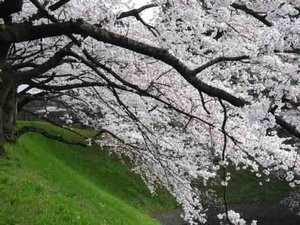Advertisement
Published: November 7th 2009

 Cherry Blossoms
Cherry Blossoms
We were lucky to be in Tokyo at the same time as the cherry blossoms were in full bloom.I'm not sure why I waited this long to visit Tokyo. It certainly wasn't as expensive as I thought, and probably even less so than New York or London these days. Years of deflation have certainly helped this cause. The city also didn't look like it was in a depression (or soon to be depression). There were more people in the shopping malls and restaurants than I could have ever imagined. The themes for this trip were food (isn't it always), people, transportation, and cleaniness.
I was surprised to see how diverse the Japanese cooking can really be. Coming from the West, we typically think of Japanese cusine as not much more than sushi. That couldn't have been further from the truth. Noodles (soba, udon, and ramen) in some form or another were the order of business for breakfast and usually lunch. While we typically have ramen noodles dried and packaged at home, they take on a whole new life when they are fresh with the right broth and toppings. The other thing that was of surprise was the different ways to eat. We kept breakfast and lunch to the that $4-9 range, but we did see set dinner menus

 Fish Market
Fish Market
The Tsukiji Fish Market is the biggest in the world.as high as $300. There was also the $115 bottled water that we saw at one of the department stores. For that price, the water better come from the glaciers of the Himilayas and transported for days by Sherpas and Yaks. We had sushi standing up, barbecuing at our table, tapas, and almost everything else in-between. One thing that was a bit disappointing was the lack of street food, but again this country is about as developed as they come, so probably no less than back home.
I also found the people to be incredibly polite. So much for the typical Japanese character protrayed in all of the World War II movies. I would see literally thousands of people moving in and out of the subway stations, but they would all line up orderly on the escalaters with those not moving standing on the left and those moving to the right -- very efficient. I also liked the bowing, as it probably cuts down on the germs passed by shaking hands. The Japanese people seemed to be very concearned about commincable diseases, as I saw literally hundreds of people a day wearing a face mask to protect themselves from

 Kamakura
Kamakura
Kamakura is one of the old capital of Japan.hay fever, which is at its prime right now.
While Tokyo is the largest city in the world, you couldn't tell by how efficiently the people moved around the city. Their subway and train system were second to none and because of it their traffic wasn't a big issue. I'm sure the lack of parkng or the cost of it had a lot to do with it. The lack of cars also contributed to the lack of pollution, which was such a nice change for a city of this size.
On top of all of this, the city was immaculant. I would feel extremely uncomfortable throwing anything on the ground. However, with that said, garbage cans were always difficult to find. I'm not sure this was related to security reasons or not. One the issue of security, I never felt threatened.
I spent the nine nights across three different hotels. Two were fabulous and ranged between $170-180USD to one that was in a great location, but very small. The only hotel room that I can think that was smaller was one that I stayed in Hong Kong. I always had a pair of pajamas at the hotels

 Ramen Noodles
Ramen Noodles
These ramen noodles are nothing like the ones we get back home.to slip into if I needed to. At my last hotel in Shinagawa, zen music would play in the garden area, which would make afternoon naps very pleasant.
Tokyo is also the vending machine capital of the world. One could by almost anything from a vending machine. As I thought about this, I thought how truly efficient it was, as it was definitely a labour saving measure.
As with Seoul, I struggled to find the clothes that were neither high end designer labels or geared towards teenagers or young adults. I did go to a couple of shopping malls in Roppongi Hills that were what I would classify as "Designer Malls". The malls and stores were a sight upons themselves. Unfortunatley, the prices in the stores reflected this…
I know that the Japanese economy is in a severe recession right now, but one couldn't have figured that out by looking at the restaurants, karoke parlours, and shopping malls, which seemed to look busier than anything I have seen back home.
On a couple of other points of interest, the toilets in Japan are second to none, and they make ours looks so primitive… The war museums

 Sign
Sign
I think we get the point...from the enemies or former enemies of the West are always worth a look. The one in Tokyo was no different. The Japanese took a fairly balanced look at their role in wars over the past 100 years. It was interesting to see their perspective on WW II, as they were highly dependent on raw materials from the west leading up to WWII, as the US was threatening trade embargos over Japan's role in Asia at that time. It was also of interest to see how the Japanese looked at the West's colonial history in Asia.
Advertisement
Tot: 0.041s; Tpl: 0.011s; cc: 8; qc: 24; dbt: 0.0209s; 1; m:domysql w:travelblog (10.17.0.13); sld: 1;
; mem: 1.1mb







